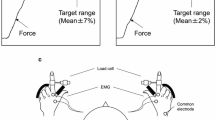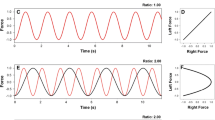Abstract
Previous research suggests that individuals use a sense of effort, more than proprioceptive feedback, to gauge force production in their upper limbs. We have adopted an isometric force matching task to determine if force asymmetry between lower limbs during bilateral force production results from a neural mechanism related to sense of effort. We hypothesized that subjects attempting to produce equal lower limb forces would generate equal percentages of their bilateral maximum voluntary strength rather than equal absolute limb forces. Ten subjects performed isometric lower limb extensions on an exercise machine. Subjects attempted to match forces in their lower limbs at three different submaximal levels (20, 40, and 60% of their weaker limb peak force during bilateral maximum voluntary contraction). Subjects received visual feedback of only the target and stronger limb force. Results showed that subjects consistently produced less force in their weaker limb during all force matching levels when normalized to their unilateral maximum voluntary contraction force (ANOVAs 20% P = 0.0473, 40% P = 0.0012, 60% P = 0.0007). As predicted by our hypothesis, normalizing force magnitudes by bilateral maximum voluntary contraction forces revealed no significant differences between limbs at all force levels (ANOVA P = 0.8490). Regardless of whether humans produce maximal or submaximal forces, limb force asymmetry appears to be related to neural factors rather than differences in mechanical capabilities between the limbs. Our findings have implications for bilateral asymmetries during movement in healthy and neurologically impaired populations.





Similar content being viewed by others
References
Bertrand AM, Mercier C, Shun PL, Bourbonnais D, Desrosiers J (2004) Effects of weakness on symmetrical bilateral grip force exertion in subjects with hemiparesis. J Neurophysiol 91:1579–1585
Bobbert MF, de Graaf WW, Jonk JN, Casius LJ (2006) Explanation of the bilateral deficit in human vertical squat jumping. J Appl Physiol 100:493–499
Carson RG, Riek S, Shahbazpour N (2002) Central and peripheral mediation of human force sensation following eccentric or concentric contractions. J Physiol 539:913–925
De Luca CJ (1985) Control properties of motor units. J Exp Biol 115:125–136
De Luca CJ, LeFever RS, McCue MP, Xenakis AP (1982a) Behaviour of human motor units in different muscles during linearly varying contractions. J Physiol 329:113–128
De Luca CJ, LeFever RS, McCue MP, Xenakis AP (1982b) Control scheme governing concurrently active human motor units during voluntary contractions. J Physiol 329:129–142
Gandevia SC, McCloskey DI (1977) Sensations of heaviness. Brain 100:345–354
Gazzaniga MS, Sperry RW (1966) Simultaneous double discrimination response following brain bisection. Psychon Sci 4:261–262
Huijing PA (2000) Length, shortening velocity, activation and fatigue are not independent factors determining muscle force exerted. In: Winters JM, Crago PE (eds) Biomechanics and neural control of movement. Springer, New York
Jakobi JM, Cafarelli E (1998) Neuromuscular drive and force production are not altered during bilateral contractions. J Appl Physiol 84:200–206
Janzen CL, Chilibeck PD, Davison KS (2006) The effect of unilateral and bilateral strength training on the bilateral deficit and lean tissue mass in post-menopausal women. Eur J Appl Physiol 97:253–260
Jones LA, Hunter IW (1983) Effect of fatigue on force sensation. Exp Neurol 81:640–650
Kawakami Y, Sale DG, MacDougall JD, Moroz JS (1998) Bilateral deficit in plantar flexion: relation to knee joint position, muscle activation, and reflex excitability. Eur J Appl Physiol Occup Physiol 77:212–216
Koh TJ, Grabiner MD, Clough CA (1993) Bilateral deficit is larger for step than for ramp isometric contractions. J Appl Physiol 74:1200–1205
Lawson BR, Stephens TM, Devoe DE, Reiser RF (2006) Lower-extremity bilateral differences during step-close and no-step countermovement jumps with concern for gender. J Strength Cond Res 20:608–619
Li S, Leonard CT (2006) The effect of enslaving on perception of finger forces. Exp Brain Res 172:301–309
Li ZM, Latash ML, Newell KM, Zatsiorsky VM (1998) Motor redundancy during maximal voluntary contraction in four-finger tasks. Exp Brain Res 122:71–78
Li ZM, Zatsiorsky VM, Li S, Danion F, Latash ML (2001) Bilateral multifinger deficits in symmetric key-pressing tasks. Exp Brain Res 140:86–94
McCloskey DI, Ebeling P, Goodwin GM (1974) Estimation of weights and tensions and apparent involvement of a “sense of effort”. Exp Neurol 42:220–232
McLean SP, Vint PF, Stember AJ (2006) Submaximal expression of the bilateral deficit. Res Q Exerc Sport 77:340–350
Mercier C, Bertrand AM, Bourbonnais D (2004) Differences in the magnitude and direction of forces during a submaximal matching task in hemiparetic subjects. Exp Brain Res 157:32–42
Milot MH, Nadeau S, Gravel D, Requiao LF (2006) Bilateral level of effort of the plantar flexors, hip flexors, and extensors during gait in hemiparetic and healthy individuals. Stroke 37:2070–2075
Newton RU, Gerber A, Nimphius S, Shim JK, Doan BK, Robertson M, Pearson DR, Craig BW, Hakkinen K, Kraemer WJ (2006) Determination of functional strength imbalance of the lower extremities. J Strength Cond Res 20:971–977
Oda S, Moritani T (1996) Interlimb co-ordination of force and movement-related cortical potentials. Eur J Appl Physiol Occup Physiol 74:8–12
Park WH, Leonard CT, Li S (2007) Perception of finger forces within the hand after index finger fatiguing exercise. Exp Brain Res 182:169–177
Proske U, Gregory JE, Morgan DL, Percival P, Weerakkody NS, Canny BJ (2004) Force matching errors following eccentric exercise. Hum Mov Sci 23:365–378
Roland PE, Ladegaard-Pedersen H (1977) A quantitative analysis of sensations of tension and of kinaesthesia in man. Evidence for a peripherally originating muscular sense and for a sense of effort. Brain 100:671–692
Schantz PG, Moritani T, Karlson E, Johansson E, Lundh A (1989) Maximal voluntary force of bilateral and unilateral leg extension. Acta Physiol Scand 136:185–192
Simon AM, Gillespie RB, Ferris DP (2007) Symmetry-based resistance as a novel means of lower limb rehabilitation. J Biomech 40:1286–1292
Sperry RW (1950) Neural basis of the spontaneous optokinetic response produced by visual inversion. J Comp Physiol Psychol 43:482–489
Taniguchi Y (1997) Lateral specificity in resistance training: the effect of bilateral and unilateral training. Eur J Appl Physiol Occup Physiol 75:144–150
Taniguchi Y (1998) Relationship between the modifications of bilateral deficit in upper and lower limbs by resistance training in humans. Eur J Appl Physiol Occup Physiol 78:226–230
Tracy BL, Enoka RM (2006) Steadiness training with light loads in the knee extensors of elderly adults. Med Sci Sports Exerc 38:735–745
Vandervoort AA, Sale DG, Moroz J (1984) Comparison of motor unit activation during unilateral and bilateral leg extension. J Appl Physiol 56:46–51
Weerakkody N, Percival P, Morgan DL, Gregory JE, Proske U (2003) Matching different levels of isometric torque in elbow flexor muscles after eccentric exercise. Exp Brain Res 149:141–150
Winter DA (2004) Biomechanics and motor control of human movement. Wiley, New York
Zatsiorsky VM, Li ZM, Latash ML (1998) Coordinated force production in multi-finger tasks: finger interaction and neural network modeling. Biol Cybern 79:139–150
Acknowledgments
The authors would like to thank the members of the University of Michigan Human Neuromechanics Laboratory for their assistance during data collections and for helpful comments on revisions of the manuscript. This research was supported in part by National Institutes of Health R01 NS045486 and the National Science Foundation GRFP.
Author information
Authors and Affiliations
Corresponding author
Rights and permissions
About this article
Cite this article
Simon, A.M., Ferris, D.P. Lower limb force production and bilateral force asymmetries are based on sense of effort. Exp Brain Res 187, 129–138 (2008). https://doi.org/10.1007/s00221-008-1288-x
Received:
Accepted:
Published:
Issue Date:
DOI: https://doi.org/10.1007/s00221-008-1288-x




